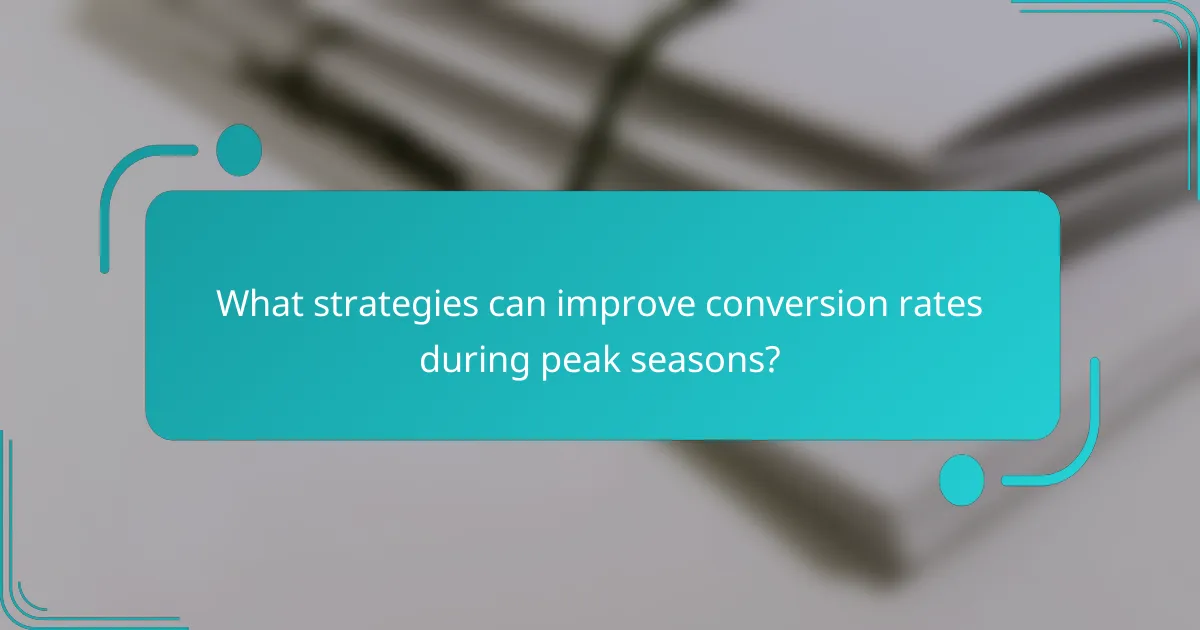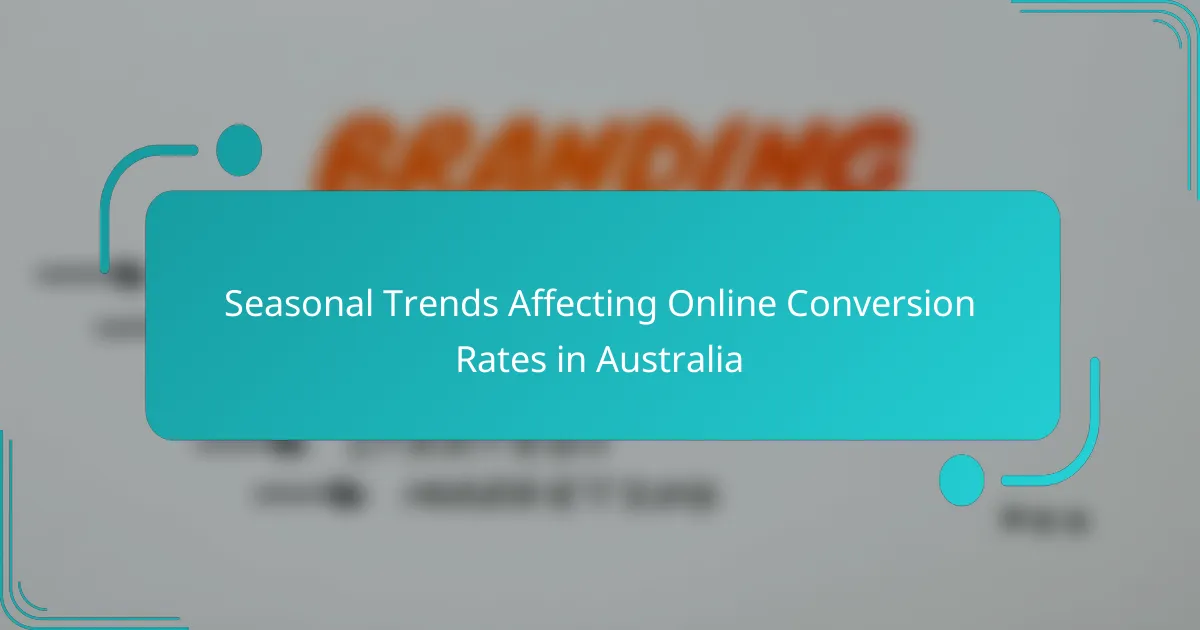Seasonal trends play a crucial role in shaping online conversion rates in Australia, as they directly affect consumer behaviour and purchasing patterns throughout the year. By recognising these trends, businesses can tailor their marketing strategies and capitalise on peak periods, enhancing their sales performance and customer engagement.

How do seasonal trends impact online conversion rates in Australia?
Seasonal trends significantly influence online conversion rates in Australia by altering consumer behaviour and purchasing patterns throughout the year. Understanding these trends can help businesses optimise their marketing strategies and improve sales performance during peak periods.
Increased sales during holiday seasons
In Australia, holiday seasons such as Christmas and Easter typically see a surge in online sales. Retailers often experience conversion rates that can increase by significant margins during these times due to heightened consumer spending and promotional activities.
To capitalise on this trend, businesses should prepare targeted marketing campaigns well in advance. Offering special discounts, creating holiday-themed promotions, and enhancing website user experience can help attract more customers and convert visits into sales.
Seasonal product demand fluctuations
Different seasons bring varying consumer needs, which can lead to fluctuations in product demand. For example, summer may see increased interest in outdoor and travel-related items, while winter often boosts sales of home goods and warm clothing.
Businesses should analyse past sales data to identify these seasonal patterns and adjust their inventory accordingly. Implementing a flexible marketing strategy that aligns with seasonal demands can enhance conversion rates by ensuring that the right products are promoted at the right time.

What strategies can improve conversion rates during peak seasons?
Improving conversion rates during peak seasons involves implementing targeted marketing campaigns and offering seasonal promotions. These strategies can effectively engage customers and encourage purchases, ultimately boosting sales during high-traffic periods.
Targeted marketing campaigns
Targeted marketing campaigns focus on specific customer segments based on their behaviours and preferences. By utilising data analytics, businesses can identify key demographics and tailor their messaging to resonate with these groups, increasing the likelihood of conversion.
For example, during the holiday season, a retailer might target families with children by promoting family-oriented products. Using personalised emails or social media ads can enhance engagement and drive traffic to the website.
Seasonal promotions and discounts
Seasonal promotions and discounts are effective tools for attracting customers during peak shopping times. Offering limited-time discounts or special deals can create a sense of urgency, prompting customers to make quicker purchasing decisions.
In Australia, retailers often use strategies like “Buy One Get One Free” or percentage discounts during events such as Black Friday or the end-of-financial-year sales. Clearly communicating these offers through various channels can significantly increase conversion rates.

Which seasonal events influence online shopping behaviour in Australia?
Several seasonal events significantly impact online shopping behaviour in Australia, driving higher conversion rates during specific periods. Key events include the Christmas shopping season and promotional days like Black Friday and Cyber Monday, which create unique opportunities for retailers to engage consumers.
Christmas shopping season
The Christmas shopping season is one of the most critical periods for online retailers in Australia. Typically starting in late November and peaking in December, consumers are actively seeking gifts, decorations, and holiday-related products. Retailers often see a surge in traffic and sales, making it essential to optimise websites for user experience and mobile accessibility.
To capitalise on this trend, businesses should consider offering promotions, free shipping, and gift guides tailored to various demographics. Engaging marketing campaigns that highlight holiday themes can also enhance visibility and attract more shoppers during this festive period.
Black Friday and Cyber Monday
Black Friday and Cyber Monday have rapidly gained popularity in Australia, occurring in late November. These shopping events are characterised by significant discounts and limited-time offers, enticing consumers to make purchases. Retailers can expect a notable increase in online traffic and conversion rates during these days.
To maximise success during Black Friday and Cyber Monday, businesses should prepare early by planning inventory, creating targeted marketing strategies, and ensuring their websites can handle increased traffic. Offering exclusive deals and early access to sales can also encourage customers to shop sooner rather than later.

How can businesses analyse seasonal trends effectively?
Businesses can analyse seasonal trends by leveraging data analytics tools and monitoring customer behaviour patterns throughout the year. Understanding these trends helps in optimising marketing strategies and improving online conversion rates.
Utilising Google Analytics for trend analysis
Google Analytics provides valuable insights into website traffic and user behaviour, making it essential for analysing seasonal trends. By setting up custom reports and tracking metrics like page views, bounce rates, and conversion rates, businesses can identify peak seasons and low-performing periods.
To effectively utilise Google Analytics, focus on comparing data from different time frames, such as year-over-year or month-over-month. This allows businesses to spot patterns and adjust their marketing strategies accordingly. For example, if a spike in traffic occurs during the holiday season, businesses can prepare targeted campaigns to capitalise on this trend.
Monitoring social media engagement
Social media platforms are crucial for gauging customer sentiment and engagement, which can reflect seasonal trends. By tracking likes, shares, comments, and overall engagement rates, businesses can determine which products or services resonate most with their audience during specific times of the year.
Consider using social media analytics tools to gather data on post performance and audience interactions. For instance, if a particular campaign performs well during a festive season, businesses can replicate similar strategies in the future. Regularly reviewing engagement metrics helps in understanding shifts in consumer preferences and adapting marketing efforts accordingly.

What are the key metrics to track for seasonal conversions?
To effectively analyse seasonal conversions, focus on metrics such as conversion rate percentage and average order value. These indicators provide insights into customer behaviour and purchasing patterns during different times of the year.
Conversion rate percentage
The conversion rate percentage measures the proportion of visitors who complete a desired action, such as making a purchase. In Australia, seasonal trends can significantly impact this metric, with rates often peaking during holidays like Christmas and Black Friday.
To optimise your conversion rate, consider factors such as website performance, user experience, and targeted marketing campaigns. A well-timed promotional offer can lead to a noticeable increase in conversions, especially during peak shopping seasons.
Average order value
Average order value (AOV) indicates the average amount spent by customers per transaction. Tracking AOV during seasonal periods helps identify trends in consumer spending, which can fluctuate based on holidays and events.
To enhance AOV, implement strategies like bundling products or offering discounts on minimum purchase amounts. For instance, during the back-to-school season, promoting package deals can encourage customers to spend more, increasing overall revenue.

How do consumer preferences change with seasons in Australia?
In Australia, consumer preferences shift significantly with the seasons, impacting online conversion rates. During warmer months, shoppers lean towards summer clothing, while winter prompts a surge in demand for home heating products.
Preference for summer clothing in warmer months
As temperatures rise, Australian consumers prioritise lightweight and breathable fabrics. Popular items include shorts, t-shirts, and swimwear, which see increased online sales from September to February.
Retailers should consider showcasing summer collections prominently on their websites during this period. Highlighting seasonal promotions and offering free shipping can further entice customers to complete their purchases.
Increased interest in home heating products in winter
When winter arrives, typically from June to August, Australians turn their attention to home heating solutions. Products such as electric heaters, heat pumps, and insulated blankets gain traction as consumers seek comfort in colder temperatures.
To capitalise on this trend, online retailers should emphasise energy efficiency and safety features in their marketing. Providing clear comparisons of heating products can help customers make informed decisions, ultimately boosting conversion rates during the winter months.

What role does mobile shopping play in seasonal trends?
Mobile shopping significantly influences seasonal trends by increasing accessibility and convenience for consumers. During peak shopping seasons, such as holidays, mobile devices often become the primary platform for online purchases, driving higher conversion rates.
Higher mobile traffic during holidays
During holiday seasons in Australia, mobile traffic typically surges as shoppers prefer the ease of browsing and purchasing on their smartphones. This shift can lead to conversion rates that are notably higher compared to other times of the year, as consumers take advantage of mobile-friendly features like one-click purchasing and personalised notifications.
Retailers should optimise their websites for mobile use, ensuring fast load times and easy navigation. A well-designed mobile experience can capture the attention of holiday shoppers, leading to increased sales and customer satisfaction.
Mobile app promotions boosting sales
Mobile app promotions are a powerful tool for enhancing sales during seasonal trends. By offering exclusive discounts or early access to sales through apps, retailers can encourage users to make purchases directly from their devices.
Implementing push notifications for app users can remind them of ongoing promotions, especially during high-traffic shopping periods. Retailers should consider integrating loyalty programs within their apps to further incentivise repeat purchases and enhance customer engagement.
